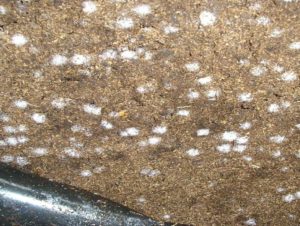Mould in peat, what to do?
Sometimes, in certain temperatures, water condensates between the peat bale and the plastic wrapping creating conditions that allow fungal growth. You may see white mould or yellow or orange powdery like growth on the surface of the peat. These fungi are not harmful to plants.
The white mould is Trichoderma. It is a naturally occurring beneficial micro-organism that lives in most soils. Usually you cannot see its presence, but sometimes it appears as white mould on the surface of peat.
Trichoderma is a group of saprophytic fungi, which inhibits the growth of plant pathogenic fungi. It is also used as a commercial biofungicide as it prevents the attacks from plant pathogenic micro-organisms during cultivation. Trichoderma is, therefore, extremely beneficial fungi which naturally protects the substrate from plant pathogens and causes no negative effect to plants.
Yellow or orange powdery like growth on the surface of peat is due toPeziza ostracoderma, commonly called as cinnamon or peat mould. It is another non-harmful but common saprophytic fungi found on peat. Saprophytic fungi live on other fungi in decaying organic material such as peat. They do not live on living plants.
Due to low pH and low oxygen levels that are natural to bogs, plant pathogenic micro-organisms are not present in our raw material. They have never occurred in our analyses. There is no need to sterilise the peat. Heating would kill the beneficial Trichoderma, and on the other hand, sterile growing media would attract harmful fungi and enhance their growth as there would be no micro-organisms, such as Trichoderma, fighting them off.

What to do, if there is mould in peat?
- Note that the peat is safe to use – the fungi is not harmful to plants. The adverse effect of saprophytic fungi is purely visual. Moreover, there is no effective fungicide available against them.
- Open the package and mix thoroughly, this will cause the fungus to collapse.
- Because fungal growth requires nutrients, the occurrence of saprophytic fungi may result in deficiency of plant available nutrients, nitrogen (N) in particular. Use fertiliser from the very beginning of growing to prevent any deficiencies.
- In dryer conditions the fungus will not become visible, so it shouldn’t reappear during cultivation. To avoid all types of fungi during cultivation, allow the surface of the substrate to dry regularly and reduce relative humidity when possible.

